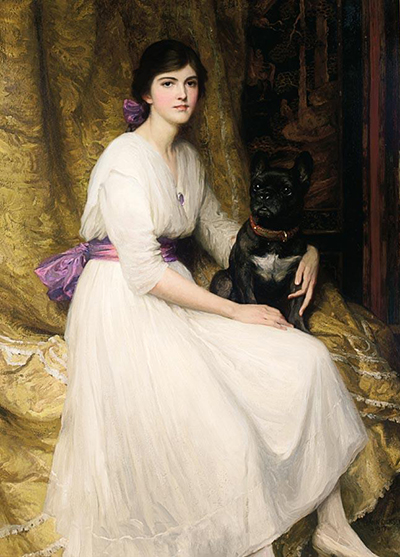Undoubtedly, you'll appreciate at its true value one of Sir Francis Bernard Dicksee's sumptuous paintings of all time. It was made by the famous painter Dicksee alongside other famous works, including the Portrait of the Artist's Niece, Dorothy.
The objects in this painting and the story they tell. The high waisted white gown casts Dorothy as virtuous. It's white, which is the colour associated with modesty at the time, even now. At the same time because it's white represents high status since cleaning was very expensive at this time. The dog in the painting seems to represent a companion to her. Animals played a vital role at the time. They symbolized a status symbol, helpers, and were ornamental.
The Portrait of the artist's niece, Dorothy, was closely related to Dicksee's early artworks as an illustrator. He used care and romanticism to illustrate the real nature of beauty with this painting. Dicksee also used a similar water-with-bodycolor technique for this painting as with his other paintings. Dicksee used oil and canvas to paint the Portrait of the artist's niece, Dorothy, in 1917. The pure white gown brings out status and a perfect union of the colour spectrum of the gold lush behind her.
At the time of painting, it's possible that the tinge of purple in the painting was an inspiration from the British suffragettes and how they used to blend their companion colours – white, purple, and green. Frank Dicksee has 116 fantastic pieces of artwork that have caught the eye of millions. As a Victorian romanticist painter, draftsman and painter, Dicksee. Some of his most striking pieces include:
- Portrait of the Artist's Niece, Dorothy - 1917
- The Daughters of Eve - 1925
- Harmony - 1877
- Romeo and Juliet - 1884
- The End of the Quest - 1921
- Chivalry 1885
- Cleopatra - 1876
These are just a few of Dicksee's masterpieces. The fascinating components of his artwork make them all the more captivating and eye-catching. Fredric Leighton and G.F. Watts were among the greatest influences of Dicksee's work. He filled his compositions with orchestrations of both colour and elaborated details. Through early studies with Henry Holiday, he grew to enjoy the detailed and decorative aspects of painting and ventured more into it. Sir Francis Bernard Dicksee was a crucial figure in the history of artworks and produced some of the best, most inspiring, interesting masterpieces. A lot of his work is displayed in museums, and art galleries, with most of them, believed to be priceless.




